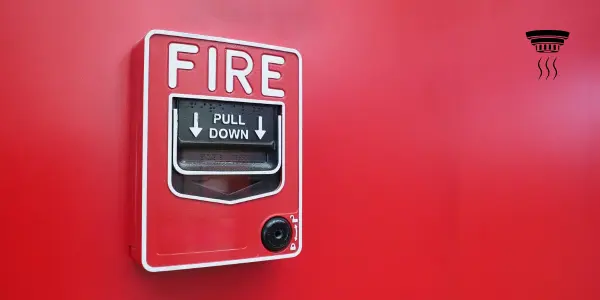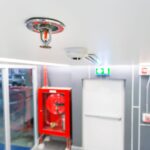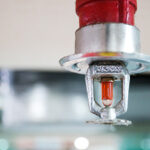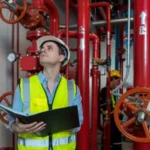A fire alarm system is a key component of any modern safety provision. It is something that detects and warns of fire situations and helps facilitate a quick evacuation to save lives and property. Installed in offices, factories, and public buildings, a fire alarm works quietly in the background – until, that is, an emergency arises. In those instances, a fire alarm system is a lifesaver. Upon activation, alarms and sounders will alert the occupants of an emergency. Most configurations will include fire monitoring facilities that help notify the fire brigade or other emergency teams from a central station. This may be a required safety feature; however, it is essential to avert disaster.
What Is a Fire Detection System?
A fire detection system is composed of several interlinked devices that work collaboratively to identify smoke, heat, or toxic gases to warn or alert people of what’s perceived as a potential danger. The Fire Alarm Control Panel (FACP) is the main component which connects these various functions, including sensors, manual call points, and alarm sounders.
The control panel can be regarded as the “brain” of the system, as it will tell the system when to go into alarm and can direct interventions for evacuating occupants. The FACP can also allow drills to occur for staff to become familiar with safe evacuation in an emergency.
How a Fire Safety System Works
The fire safety system operates on the principle of recognizing early indications of fire and warning building occupants to respond urgently. Sensors distributed across the building recognize heat, smoke, or carbon monoxide, which send signals to the control panel. When confirmed, alarms ring, lights flash, and in advanced systems, automatic notifications go to emergency responders.
In new construction, the system also splits the space into “zones,” which allows for more accurate identification of the specific fire location. Most systems are also tied to fire protection system components like sprinklers, HVAC shut-down controls, and emergency exit releases to provide a well-coordinated safety response.
Types of Fire Detectors
The detection devices are the heart of any fire alarm system. Following are the most important types used in buildings:
1. Heat Detectors
They sense temperature variations and may trigger alarms when a particular temperature is reached or rapidly increasing heat. They are most effective in spaces like kitchen areas or mechanical rooms where the installation of smoke detectors would trigger false alarms.
2. Smoke Detectors
There are three general types of smoke detectors:
- Ionization detectors – They detect smoke particles that interfere with electrical currents in an ionized chamber.
- Light scattering detectors – These rely on the Tyndall effect, detecting light scattered off smoke particles.
- Light blocking detectors – These detect light blockage between a source and sensor to determine if there is smoke.
3. Carbon Monoxide (CO) Detectors
These CO alarms can sense the presence of carbon monoxide, a colorless, odorless gas that frequently occurs as a result of fires. They react faster to low levels of gas than do standard household CO alarms.
4. Multi-Sensor Detectors
These detectors combine optical and heat smoke sensors, comparing information from both to define actual fire conditions and reduce false alarms.
5. Manual Call Points
Commonly called break glass units, these allow individuals to activate the alarm manually in case they sense a fire before detectors.
Types of Fire Alarm Systems
There are four types of fire alarm systems, each of which is ideal for varying building sizes and requirements.
1. Traditional Fire Alarm
This is the most basic arrangement, where call points and detectors are linked through cabling in specific “zones.” The control panel isolates the affected zone when an alarm is raised. Simple as it may be, it’s a good one and suitable for small buildings.
2. Addressable Fire Alarm
In addressable fire alarm, a separate address is assigned to every device or detector so that the control panel can identify the specific location where the trigger is being sent. It employs loop wiring and has isolation modules to avoid disabling the whole circuit by a single fault.
3. Intelligent Systems
A high-tech upgrade on the addressable variety, smart systems employ sensors with integral microprocessors that read their surroundings and report accurate information to the control panel—reducing false alarms and making fire alarm maintenance easier.
4. Wireless Fire Alarm
A wireless fire alarm system links panels and sensors through secure radio communication rather than wiring. It’s the best for heritage sites or buildings where installation work must be minimal. Though it’s cable-free, it’s as reliable as a wired system and offers full coverage.
Summary
An appropriately designed fire alarm system is much more than a legal requirement; it is an investment in life. By detecting fires at an early stage and warning occupants of the risk, it minimizes injury to people and protection to property, therefore reducing loss. Whether the installation is of conventional fire alarm system, addressable fire alarm system, or wireless fire alarm system, these all contribute to modern day protection in buildings. When working with the fire alarm system is done properly, timely fire alarm installation, maintenance of fire alarms, and good monitoring of fire alarms, you are protecting the building, yourself, and anyone who comes to visit.
Frequently Asked Questions (FAQs)
1. Why is a fire alarm system necessary?
It gives early warning and detection, enabling safe evacuation and reducing fire-related losses.
2. What’s the key difference between addressable and conventional fire alarm systems?
A traditional system indicates the fire area, but an addressable system specifies the precise device which initiated the alarm.
3. How frequently must fire alarms be tested?
Systems need to be tested weekly or monthly, with professional checks done at least annually.
4. Are wireless fire alarm systems trustworthy?
Yes, they employ secure radio communication technology and are just as reliable as wired systems, suitable for complicated or historic buildings.
5. What comprises fire alarm maintenance?
It involves inspecting detectors, batteries, sounders, and communication modules to guarantee the system’s effectiveness.
6. How do fire safety solutions increase protection?
By incorporating alarms, sprinklers, lighting, and monitoring, they provide an integrated, cohesive response that optimizes fire safety.







